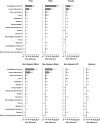Leading cancers contributing to educational disparities in cancer mortality in the US, 2017
- PMID: 34244895
- PMCID: PMC8492562
- DOI: 10.1007/s10552-021-01471-9
Leading cancers contributing to educational disparities in cancer mortality in the US, 2017
Abstract
Purpose: To inform prevention efforts, we sought to determine which cancer types contribute the most to cancer mortality disparities by individual-level education using national death certificate data for 2017.
Methods: Information on all US deaths occurring in 2017 among 25-84-year-olds was ascertained from national death certificate data, which include cause of death and educational attainment. Education was classified as high school or less (≤ 12 years), some college or diploma (13-15 years), and Bachelor's degree or higher (≥ 16 years). Cancer mortality rate differences (RD) were calculated by subtracting age-adjusted mortality rates (AMR) among those with ≥ 16 years of education from AMR among those with ≤ 12 years.
Results: The cancer mortality rate difference between those with a Bachelor's degree or more vs. high school or less education was 72 deaths per 100,000 person-years. Lung cancer deaths account for over half (53%) of the RD for cancer mortality by education in the US.
Conclusion: Efforts to reduce smoking, particularly among persons with less education, would contribute substantially to reducing educational disparities in lung cancer and overall cancer mortality.
Keywords: Cancer mortality; Disparities; Education; Lung cancer; Risk difference.
© 2021. The Author(s).
Conflict of interest statement
The authors have no conflicts of interest to disclose.
Figures

References
-
- National Center for Health Statistics: Datasets and Related Documentation for Mortality Data (2016) https://www.cdc.gov/nchs/nvss/mortality_methods.htm. Accessed 29 Apr 2021
MeSH terms
LinkOut - more resources
Full Text Sources
Medical
Miscellaneous

